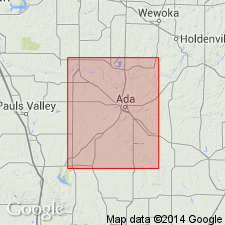
- Usage in publication:
-
- Vanoss formation
- Modifications:
-
- Named
- Dominant lithology:
-
- Sandstone
- Conglomerate
- Shale
- Limestone
- AAPG geologic province:
-
- Arkoma basin
Summary:
Named for town of Vanoss, situated on the outcrop in north-central part of T3N, R4E, Pontotoc Co, OK, Arkoma basin, as basal of 3 formations of Pontotoc terrane [Group], newly named this report. No type locality designated. Overlies Ada formation (new)--contact between them is plane dividing arkosic and nonarkosic materials; underlies Hart limestone member of Stratford formation of Pontotoc (all new). Consists of alternating sandstones, conglomerates, shales, and a few thin limestones. All strata are arkosic, some of the sandstones so much so that they might be taken for true granites. Arkosic material decreases upward, as sandstones become less prominent. Near center of formation there are several thin limestone beds (not observed north of Canadian River) that are generally argillaceous, grading into shale; they are light gray and relatively soft when fresh, but upon weathering become hard and white. Shales, predominant in upper portion, are light in color, ranging through shades of green and gray, with occasional red shale. Thickness increases southward. Exposed portion east of Konawa is only about 250 ft, while near southwest corner of quad is about 650 ft thick. Fauna found in the formation, though mostly composed of species extending into the Permian, is strongly suggestive of Pennsylvanian age. Fossil list; includes several plant species, as well as gastropods, pelecypods, and brachiopods. Generalized columnar section, geologic map.
Source: GNU records (USGS DDS-6; Denver GNULEX).
For more information, please contact Nancy Stamm, Geologic Names Committee Secretary.
Asterisk (*) indicates published by U.S. Geological Survey authors.
"No current usage" (†) implies that a name has been abandoned or has fallen into disuse. Former usage and, if known, replacement name given in parentheses ( ).
Slash (/) indicates name conflicts with nomenclatural guidelines (CSN, 1933; ACSN, 1961, 1970; NACSN, 1983, 2005, 2021). May be explained within brackets ([ ]).

